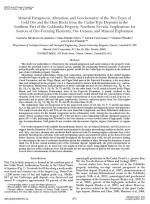Добрый день, Коллеги. Важное сообщение, просьба принять участие. Музей Ферсмана ищет помощь для реставрационных работ в помещении. Подробности по ссылке
Mineral paragenesis, alteration, and geochemistry of the two types of gold ore and the host rocks from the carlin-type deposits in the southern part of the Goldstrike Property, Northern Nevada: implications for sources of ore-forming elements, ore genesis
This study was undertaken to characterize the mineral paragenesis and metal zoning at the property scale, evaluate the potential sources of ore-related metals, quantify the relationship between intensity of alteration and gold grade, and propose a comprehensive genetic model for the Carlin-type Au deposits at the southern part of the Goldstrike property, Nevada.
Mineralogy, textural relationships, whole-rock composition, and spatial distribution of the studied samples revealed two types of gold ore: Ore I and II. The former, which is hosted by the Roberts Mountains and Rodeo Creek Formations, and the Wispy, Planar, and Upper Mud units of the Popovich Formation, is the most abundant and widespread in the property. Ore I is characterized by intense hydrothermal alteration (e.g., carbonate dissolution, silicification, and precipitation of pyrite) and high amounts of trace elements (e.g., Ag, As, Au, Ba, Cd, Cu, Hg, Mo, Ni, S, Sb, Se, Te, Tl, and Zn). On the other hand, Ore II, which is hosted in the Wispy, Planar, and Soft Sediment Deformation units of the Popovich Formation, is mainly confined to the central-north-northwest portion of the Screamer deposit and is weakly altered with low concentration of trace elements. Both Ores I and II contain similar average concentrations of Au in whole rock (14 and 19 g/t Au, respectively) and in pyrite (290 and 540 ppm, respectively); however, auriferous pyrite from Ore I has higher trace element (As, Ag, Cu, Hg, Ni, Sb, Se, and Tl)/Au ratios than Ore II.
The sedimentary units are interpreted to be the major local source of Cd, Mo, Ni, U, V, and Zn and minor As, Cu, Hg, and Se as denoted by the composition of least altered samples and diagenetic pyrite and sphalerite. This study reveals that Al2O3 and TiO2 are the most immobile compounds, and their distribution indicates a homogeneous source for the detrital components in the sedimentary rocks. Among the ore-related trace elements, Tl best correlates with Au grade (R2 = 0.69) and shows some relationship with the calculated amount of pyrite (R2 = 0.49), indicating that Tl would be the best element to vector toward zones of high-grade Carlin-type Au mineralization. Gold grades do not correlate with the amount of pyrite, degree of alteration, or organic C.
Our results integrated with available thermodynamic data for Au, ore-related elements, and SiO2 lead us to suggest that the formation of Ore I occurred more proximal to the major mineralizing conduits as the hot, more acid, SiO2- and trace element-rich auriferous fluids interacted with Fe-bearing impure carbonate host rocks, intensely dissolving the carbonate rocks and precipitating quartz and auriferous pyrite in the Betze-Post and Rodeo deposits. As the fluids moved laterally throughout the favorable host rocks, the pH increased, leading to a decreasing in the rate of carbonate dissolution and in the solubility of silica, favoring the formation of more distal Ore II in the central-northern part of the Screamer deposit. Significantly, the gold concentrations in whole rock and in pyrite are, in some way, very similar in both ore types, being slightly higher in Ore II, suggesting that less acidic conditions were still favorable for the incorporation of gold in the structure of pyrite, even at lower concentrations of other trace elements.




